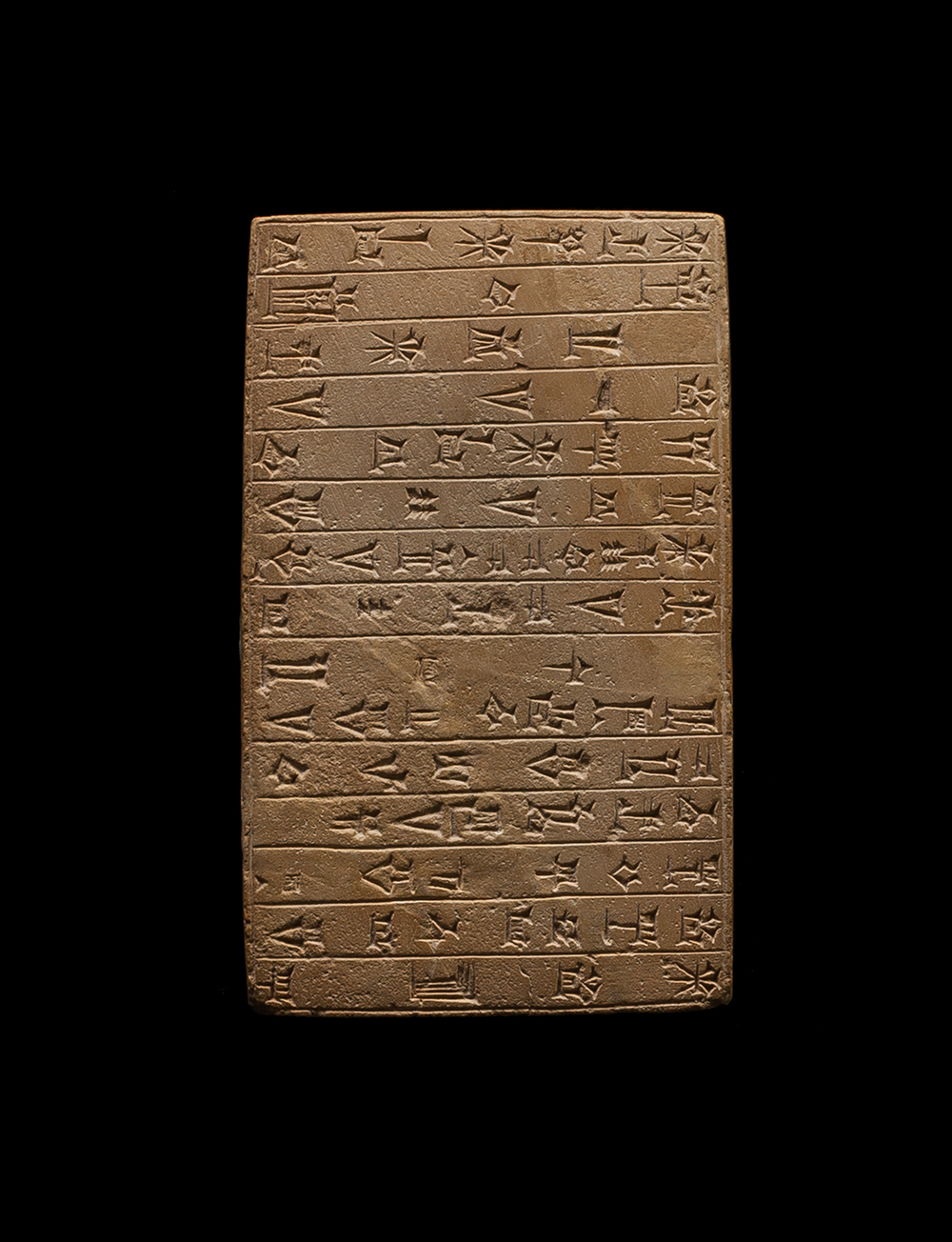

Cuneiform tablet with dedication
Babylon, Isin-Larsa period, reign of Rim-Sin I, 1822-1763 BC
Indurated limestone
H. 11.7 cm
Published: Royal Inscriptions of Mesopotamia, Early Period, (RIME 4.02.14.16), Douglas R. Frayne, 1990, p293-294.
Antiquities, Christie’s, New York, 4 June 2015, Lot 115.
Provenance: Previously with Elias S. David (1891-1969), New York, from at least 1969 (possibly documented in 1966).
Thence by descent.
Sold at: Antiquities, Christie’s, New York, 4 June 2015, Lot 115.
Paris Art Market, acquired at the above sale.
Private Collection, acquired from the above.
楔形文字獻詞泥板
巴比倫, 伊辛-拉爾薩時代, 瑞姆辛一世, 公元前1822-1763年
硬化石灰石
高. 11.7公分
出版:Douglas R. Frayne著《早期美索不達米亞皇家銘文》, 1990年, 293-294頁; 佳士得《古董》, 紐約, 2015年6月4日, 第115號。
來源:Elias S. David (1891-1969)收藏, 紐約, 最遲於1969年開始收藏(可能始於1966年); 遺產繼承;
2015年6月4日於紐約佳士得古董拍賣售出, 編號第115 號;
巴黎藝術市場, 購自上述; 私人收藏, 購自上述。
Rectangular in form, one convex side and one flat, with fourteen lines of Sumerian cuneiform on each side, recording the restoration of the Temple E-a-ga-ga-kilib-ur-ur for the goddess Ninegal by the wife of King Rim-Sin of Larsa, reading: “For the goddess Ninegal, great lady who holds all the me’s in her hands, who looks at the numerous people, supreme advisor who looks after the black-headed people, whose ways are not rivaled, aristocrat whose word excels in the assembly, whose name is noble enough for praise, reliable goddess from (her) father who engendered her, whose utterance is favourable, great daughter of the god Sin, her lady, Simat-Eshtar beloved spouse of Rim-Sin, King of Larsa, daughter of Warad-Nanna, when the goddess Ninegal, her lady, called her good name, she built for her E-a-ag-ga-kilib-ur-ur, the residence suitable for her divinity, to establish the life of Rim-Sin forever, and for her own life. She enlarged its e-shu-si-ga more than it had been previously. She placed there for the future her foundation inscription proclaiming her queenly name” Obverse 1. {d}nin-e2-gal 2. nin gal me kilib3 szu-na dab5-be2 3. ug3 szar2-ra-asz igi-bi gal2 4. na-de5 mah szita5-du3 sag-[ge6] 5. a-ra2-bi za3 nu-sa2 6. nir-gal2 ukken-na du11-ga-ni igi-sze3 du 7. mu-ni a-re-esz gi7 8. dingir zi ki a-a ugu-ni-ta 9. ka ba-ni sze-ga 10. dumu gal {d}suen-na 11. nin-a#-ni-ir 12. si#-ma-at-{d}inanna 13. dam ki-ag2 14. {d}ri-im-{d}suen Reverse 15. lugal larsa{ki}-ma 16. dumu-munus ARAD2-{d}nanna-ke4 17. u4 {d}nin-e2-gal nin-a-ne2 18. mu sa6-ga-ni in-sa4-a 19. e2 a2-ag2-ga2 kilib3 ur4-ur4 20. ki-tusz nam-dingir-bi-sze3 tum2-ma 21. nam-ti {d}ri-im-{d}suen 22. u4 da-ri2-sze3 gal2-le-de3 23. u3 nam-ti-la-ni-sze3 24. mu-na-du3 25. diri u4-bi-ta-sze3 26. e2-szu-si3-ga-bi mu-un-dagal 27. temen mu# pa3-da nam-nin-a-ka-na 28. u4 su13-ra2-sze3 im-mi-in-gar The Goddess Ninegal, was known as the “Queen of Heaven” and was later assimilated into Inanna in the Old Babylonian period, and further combined with the goddess Ishtar by the Akkadians to become Inanna-Ishtar. She was the patron goddess of the Eanna temple at the city of Uruk, which was her main cult centre. During the post-Sargonic era Ninegal became one of the most widely venerated deities in the Sumerian pantheon, with temples across Mesopotamia. As Inanna-Ishtar she appears in more myths than any other Sumerian deity.
Published:
Douglas R. Frayne, Royal Inscriptions of Mesopotamia, Early Period, Toronto and London 1990 (RIME 4.02.14.16), pp. 293–94
Antiquities sale, Christie’s, New York, 4 June 2015, lot 115
Recorded in the CDLI database (https://cdli.ucla.edu/) as no. P480740
